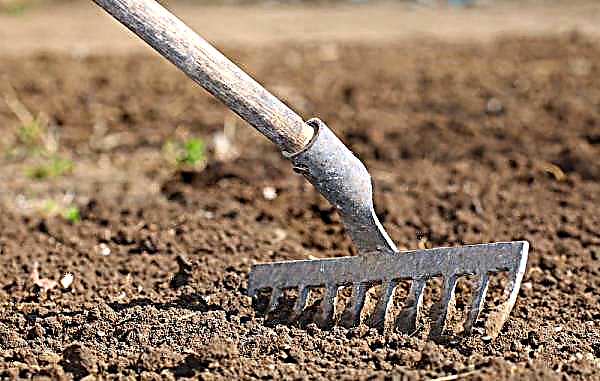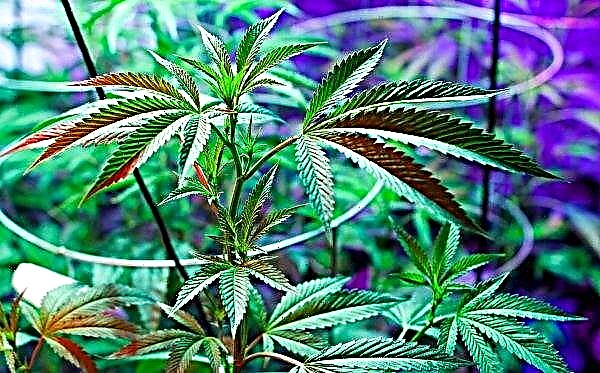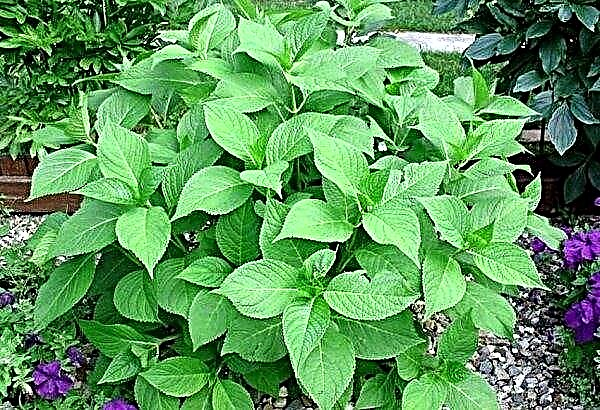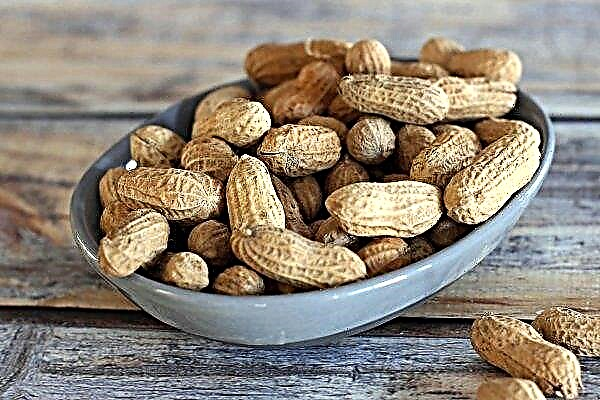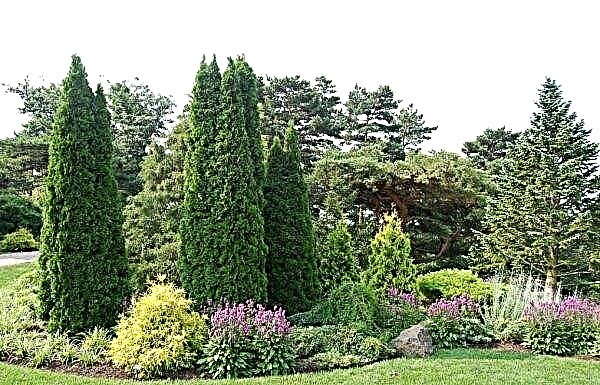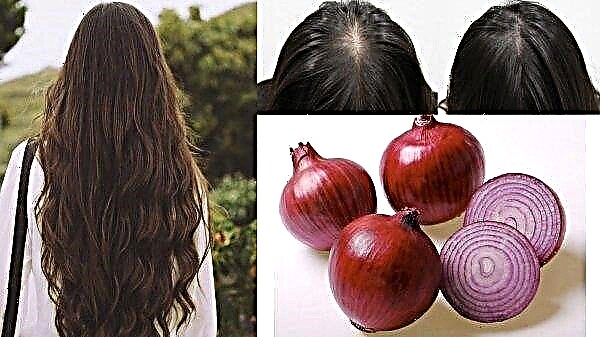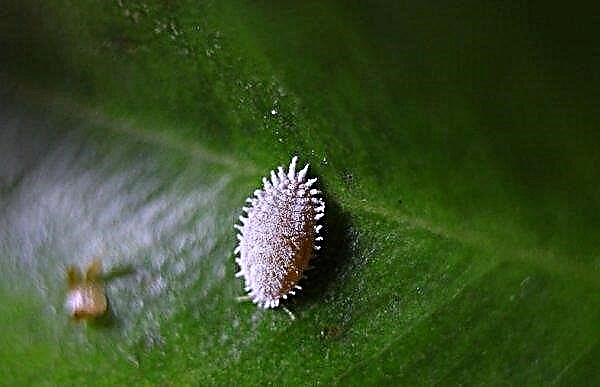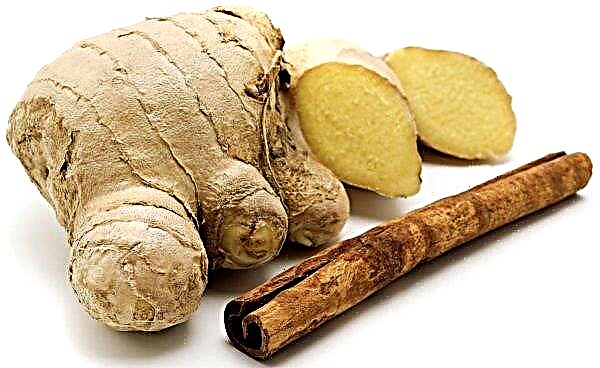Often nature is the best doctor in the world, because it is rich in many medicinal plants. Some of them grow in our regions, others have a limited distribution area, and you can find them either in a specific area or on pharmacy shelves. The second of these groups includes a healing culture, known in science as Adams rhododendron. What is this plant and how to use it for medicinal purposes, read on.
Botanical Description
Rhododendron Adams is also called Sagan-Dail, fragrant rosemary or rod, Belogorsk or Buryat tea, white wing.
They recognize Adams Rhododendron by its characteristic description:
- the height of the evergreen shrub 0.5 m;
- a dark gray shade of old lignified shoots with a brown base color. Branches tend to peel. Under the layer of the old bark a young saturated green is seen;
- white color of the inner part of the stems. After some time, the fault site becomes brown;
- small oblong-lanceolate leaves with rounded edges and a length of about 2 cm. Young foliage is painted green-brown, after a year of life, it acquires a reddish-brown hue. The leaves have a specific aroma, thanks to which Sagan-Daila is easily distinguishable from other varieties of rhododendrons;
- the color of the buds. With the beginning of summer, the shrub is covered with medium-sized (up to 1.5 cm in diameter) pink flowers of various shades, from pale purple (almost white) to deep dark, even raspberry. In one inflorescence, located on the tip of the branch, there are about 12-15 flowers that have no aroma at all;
- superficial root system.

Beneficial features
Rhododendron Adams is widely used in both folk and traditional medicine.
- This is due to many of its useful properties:
- improvement of brain activity;
- normalization of the heart and kidneys;
- the ability to relieve pain of a different nature;
- decreased heat during illness;
- elimination of symptoms of rheumatism, fever, diseases of the nervous system;
- increase immunity;
- the ability to improve the activity of the circulatory and digestive systems;
- the possibility of using as a diuretic and antibacterial agent.

Chemical composition
The benefits of Sagan-Dail are due to its rich chemical composition. The plant contains a lot:
- tannins;
- essential oils (farnesen, nerolidol, germacron);
- organic acids (ascorbic, ursulic, oleanolic);
- phenol;
- resinous substances;
- tannids;
- flavonoids (hyperoside, avicularin, azaleatin, myricetin, quercetin-arabinoside, quercetin-5-methyl ether).

Where it grows in nature
Culture is almost impossible to grow in your own garden, because it is quite picky and demanding. In order for the plant to take root, it needs to provide a natural habitat with mountain slopes, winds and soil poor in nutrients. Rhododendron on the slopes of the mountains of Tibet, the Far East, Siberia, the Caucasus, South China, the Himalayas, Southeast Asia, and North America is used to just such conditions.
Did you know? In Japan, rhododendrons are known as “bushes of temptation,” which is explained by the content of andrometodoxin, a substance that can lead a person into a state of mild intoxication.
Collection and Harvesting
For the preparation of medicines, it is necessary to collect and harvest leafy apical parts of the fragrant bush of Adams rhododendron. Harvest time is the period from the beginning of flowering to fruit formation. Collected parts of Sagan-Dayl need to be dried in partial shade.
The procurement procedure includes the following steps:
- Choosing the right plant: its age should be at least 2-3 years.
- Direct collection of leaves, stems and flowers.
- Drying. The raw materials are laid out in a dark, warm, well-ventilated room (can be under a canopy) on a clean, solid surface or fabric. The layer should be thin. During the drying process, the collected parts of the plant must be regularly mixed. The fact that the raw material has already dried can be verified by compressing it in a fist: dry tops easily breaks.
- Store the healing dried rhododendron in a tightly closed glass container. Shelf life is 2 years. The place where you leave the container should be dark, the recommended temperature is + 5 ° C.
Grass application
Depending on the purpose of use, Adams grass has its own characteristics of application: in the form of tea, infusion, powder, tincture. Read more about the recipe below.
Video: Adams Rhododendron Properties and Uses
Tea
In folk medicine, tea made from Adams rhododendron is very popular. Such a drug helps to overcome diseases of various etiologies caused by the activity of pathogenic agents. The use of a rhododendric tea drink stimulates the quality of the heart, helps to eliminate the symptoms of kidney diseases, colds, SARS and influenza, tones the body, helps to calm down after a nervous breakdown, relieves stress.
With chilled tea, you need to gargle the throat and oral cavity in the presence of inflammation. Also, the tool has established itself as an effective encouraging drink, which increases the efficiency of the body. The healing power of tea was appreciated by those who at least once in their lives suffered from a hangover syndrome. For men, the drink is a real elixir of youth and strength, as it increases potency.Did you know? Large-leaf rhododendron is a symbol of Washington.

To make rhododendron tea you will need:
- 2 raw or 4 dry leaves;
- 1 tbsp. hot water;
- 1 tbsp. milk.
Important! Inappropriate use of funds from Adams rhododendron can be hazardous to health, because the plant belongs to poisonous species.
The cooking procedure consists of the following steps:
- Put the raw materials on the bottom of the kettle.
- Pour with water (recommended temperature - 80–90 ° С).
- Insist for about 10 minutes.
- Strain the drink.
- Add milk to it.
- Boil it.
- Add salt, pepper, cream, or lemon, sugar and honey to tea, focusing on personal taste preferences.
 Do not drink tea in the evening, before bedtime, as it charges with vigor, it will be difficult to sleep.
Do not drink tea in the evening, before bedtime, as it charges with vigor, it will be difficult to sleep.
If you have crushed raw rhododendron, you need to take half a teaspoon to make tea. The recommended dosage is 100 ml, the frequency of admission is 2 times a day. The course of treatment is from 14 to 30 days.
Important! Tea from the plant has a diuretic effect, so you need to drink it in moderation. Excessive consumption negatively affects the genitourinary system.
Infusion and tincture
Tincture is prepared from the leaves of rhododendron and vodka, combining the ingredients in a ratio of 1:10. The components must be mixed and left in room conditions. After 7 days, the product can be consumed. Take tincture of 10 drops three times a day. It is preliminary worth diluting it in half a glass of water. Such a folk remedy will relieve fatigue, favorably affects the work of the cardiovascular, circulatory systems. The course of treatment is 3 weeks.
Take tincture of 10 drops three times a day. It is preliminary worth diluting it in half a glass of water. Such a folk remedy will relieve fatigue, favorably affects the work of the cardiovascular, circulatory systems. The course of treatment is 3 weeks.
The infusion from the leaves of Sagan-Dail is effective in treating seizures of epilepsy, and is also used to improve sleep, eliminate symptoms of insomnia, and relieve nervous disorders.
To prepare a medicinal infusion, dried foliage and flowers of the culture in an amount of 2 g are filled with 200 ml of water and insisted for 20 minutes. Then strain and take 1 tbsp. l three times a day for two weeks. After 14 days, you need to take a break and repeat the course.
Powder
Rhododendron powder is obtained by grinding the dried raw material. The tool is effective in combating pathogens in the body. The powder is widely used as a medicine to enhance immunity. It is mixed with reed or honey of bees and taken daily for 1 hour on an empty stomach.
Contraindications
Despite the huge benefits, rhododendron has contraindications. Therefore, before you begin self-medication, be sure to consult your doctor.
- So, medicines from the culture should not be taken:
- allergy sufferers and those suffering from individual intolerance to the plant;
- with increased excitability;
- women in position or during lactation;
- persons under the age of majority;
- suffering from kidney disease and tissue necrosis.

